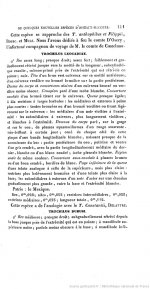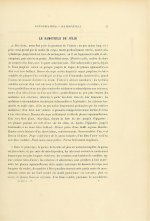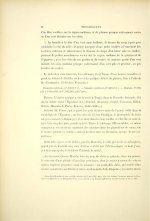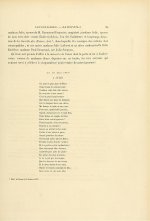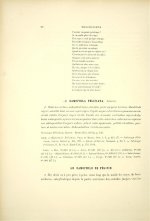-
Welcome to BirdForum, the internet's largest birding community with thousands of members from all over the world. The forums are dedicated to wild birds, birding, binoculars and equipment and all that goes with it.
Please register for an account to take part in the discussions in the forum, post your pictures in the gallery and more.
You are using an out of date browser. It may not display this or other websites correctly.
You should upgrade or use an alternative browser.
You should upgrade or use an alternative browser.
Taphrospilus (1 Viewer)
- Thread starter Taphrospilus
- Start date
More options
Who Replied?Björn Bergenholtz
(former alias "Calalp")

I apparently couldn´t stay away from this thread ...
I still don´t understand why we cling on to any particular eponym. Why not a toponym?
There are at least two small villages/towns called Leocadio (Guerrero) in Central Mexico (in the vicinity where this subspecies is present), that could easily have been latinized to leocadiae and "Frenchified" to Léocadie ...
Couldn´t that "L'Héliomastre de Léocadie", as well, be interpreted as the "... from Léocadie/Leocadio"?
Or does the last sentence, in French (that I know very little of), from the type description (attached) indicates that it, with no doubt, has to be a eponym? "Cette espèce a de l'analogie avec ... "
I still don´t understand why we cling on to any particular eponym. Why not a toponym?
There are at least two small villages/towns called Leocadio (Guerrero) in Central Mexico (in the vicinity where this subspecies is present), that could easily have been latinized to leocadiae and "Frenchified" to Léocadie ...
Couldn´t that "L'Héliomastre de Léocadie", as well, be interpreted as the "... from Léocadie/Leocadio"?
Or does the last sentence, in French (that I know very little of), from the type description (attached) indicates that it, with no doubt, has to be a eponym? "Cette espèce a de l'analogie avec ... "
Attachments
Taphrospilus
Well-known member
Your comment make absoluetly sense. Unfortunatelly we do not know where the skin was collected and by whome.
James Jobling
Well-known member

My money is still on leocadiae being an eponym, which the French trochilidists were very fond of using. The toponymic forms would be leocadiensis or leocadianus. The final sentence of the original description refers to the bird's relationship to H. constantii (de Lattre, 1843) (of which it is now treated as a subspecies).
Thanks to your inputs, my MS finally reads:
aline Benoîte-Aline Bourcier née Jusserand (fl. 1860) wife of French diplomat and trochilidist C.-M. Jules Bourcier (Eriocnemis).
leocadiae Female eponym; dedication not given (Bourcier & Mulsant 1852, Ann. Sci. Phys. Nat. d'Agric. Ind., Soc. Nat., Lyon, sér 2, 4, 141) ("dedicado a Leocadia, esposa de Bourcier" (Alvarado 1915) (but see aline)) (subsp. Heliomaster constantii).
Thanks to your inputs, my MS finally reads:
aline Benoîte-Aline Bourcier née Jusserand (fl. 1860) wife of French diplomat and trochilidist C.-M. Jules Bourcier (Eriocnemis).
leocadiae Female eponym; dedication not given (Bourcier & Mulsant 1852, Ann. Sci. Phys. Nat. d'Agric. Ind., Soc. Nat., Lyon, sér 2, 4, 141) ("dedicado a Leocadia, esposa de Bourcier" (Alvarado 1915) (but see aline)) (subsp. Heliomaster constantii).
Björn Bergenholtz
(former alias "Calalp")

I rest my case ... and switch focus
Ok, James, it might be the case ... those French ornithologist's sure love their Women!
And while we´re stuck on Bourcier and Mulsant, let´s look at yet another Hummingbird of theirs ... first with a small correction of mine:
... but I wonder if that´s all, if she´s the only woman behind that name (regarding this particular Hummingbird)?!
See the attached pages (from Mulsant & Verreaux 1876). For me, with my limited knowledge of French, there seem to be quite a few, various(!) Julie's on this single species!?
Anyone knowing French feel up to explaining what all those Julie's on pp. 58-59 is/was all about? And what about the Poetry!?
Ok, James, it might be the case ... those French ornithologist's sure love their Women!
And while we´re stuck on Bourcier and Mulsant, let´s look at yet another Hummingbird of theirs ... first with a small correction of mine:
= Anne-Julie Mulsant, born Ronchevol (1801–1868) commmorated in Violet-bellied Hummingbird Damophila julie BOURCIER 1842 a k a "Julie's Hummingbird" ...In 1816 Étienne Mulsant seem to have married his cousin Julie Ronchivole (15 years old at the time!) ... but what happened after that I don´t know.
... but I wonder if that´s all, if she´s the only woman behind that name (regarding this particular Hummingbird)?!
See the attached pages (from Mulsant & Verreaux 1876). For me, with my limited knowledge of French, there seem to be quite a few, various(!) Julie's on this single species!?
Anyone knowing French feel up to explaining what all those Julie's on pp. 58-59 is/was all about? And what about the Poetry!?
Attachments
Last edited:
Taphrospilus
Well-known member
http://reader.digitale-sammlungen.de/de/fs1/object/display/bsb10499769_00431.html you have to find out who inspired him Lettres à Julie sur l'entomologie. :t:
Taphrospilus
Well-known member
On http://books.google.de/books?id=fCVBs1OOPY8C&printsec=frontcover&hl=de#v=onepage&q&f=false (a couple of pages later) it is written "A ma femme", means "For my wife".
Last edited:
Mulsant wrote: this bird is named after my wife Julie by the late Bourcier (not an exact translation).
Next he says that everytime he sees this beautiful bird this makes him think of all the Julie's in his life. And mentions them all one after the other. Finally he includes a poem he wrote for the 15th anniversary of their mariage.
But all these Julie's are not commemorated in the bird's name, only in Mulsant's memory.
Theo
Next he says that everytime he sees this beautiful bird this makes him think of all the Julie's in his life. And mentions them all one after the other. Finally he includes a poem he wrote for the 15th anniversary of their mariage.
But all these Julie's are not commemorated in the bird's name, only in Mulsant's memory.
Theo
Björn Bergenholtz
(former alias "Calalp")

Thanks Theo!
That´s what I thought, and expected ...
I just wanted to make sure.
Cheers!
That´s what I thought, and expected ...
I just wanted to make sure.
Cheers!
l_raty
laurent raty
Actual translations would give, more or less:
"This beautiful species was dedicated, by the late Bourcier, to the one who had been able, when I was eighteen, to inspire my Letters to Julie about entomology, and whose hand I had the happiness to obtain a short time later (1).
(1) Anne-Julie Ronchevol, born in 1801, deceased on 5 June 1868. With her the old house of Ronchevol or Ronchivol, in Beaujolais, went extinct."
"To the charming hummingbird gifted with the name Julie, is tied, in my mind, the remembrance of a pleiad of lovable persons, whose memory I'd be happy to see perpetuated by this feathered sphinx as well: my granddaughter Julie," [etc.: list of Julies.]
"Let me offer, to the memory of the friend, the loss of whom is to me so painful, like humble flowers on her grave, the following verses that were used to commemorate the 50th anniversary of our hymen!"
L -
"This beautiful species was dedicated, by the late Bourcier, to the one who had been able, when I was eighteen, to inspire my Letters to Julie about entomology, and whose hand I had the happiness to obtain a short time later (1).
(1) Anne-Julie Ronchevol, born in 1801, deceased on 5 June 1868. With her the old house of Ronchevol or Ronchivol, in Beaujolais, went extinct."
"To the charming hummingbird gifted with the name Julie, is tied, in my mind, the remembrance of a pleiad of lovable persons, whose memory I'd be happy to see perpetuated by this feathered sphinx as well: my granddaughter Julie," [etc.: list of Julies.]
"Let me offer, to the memory of the friend, the loss of whom is to me so painful, like humble flowers on her grave, the following verses that were used to commemorate the 50th anniversary of our hymen!"
L -
Taphrospilus
Well-known member
A monograph of the Trochilidæ, or family of humming birds
As I understood John Gould published 5 volumes (1849-1861) of "A monograph of the Trochilidæ, or family of humming birds". The five volumes have been published in 25 parts.
The question is which plate is part of which of the 25 parts? And which part was published in which year?
At World bird info e,g. here http://worldbirdinfo.net/Pages/Bird...Field=8&BirdSearch=TROCHILIDAE%3AHummingbirds you can find e.g. Phaëthornis striigularis Gould,1854,A monograph of the Trochilidæ, or family of humming birds,pt.8,pl.[15] and text [ = 1, pl. 37 of volume]. (Bogotá,Colombia.)
This means it was part 8 plate 15 (which is equal to Vol 1 plate 37) of the delivery and dated 1854. But how about e.g. Campylopterus delattre http://www.biodiversitylibrary.org/item/108332#page/26/mode/1up which is in fact Campylopterus hemileucurus. Which part of the deliveries and in which year?
As I understood John Gould published 5 volumes (1849-1861) of "A monograph of the Trochilidæ, or family of humming birds". The five volumes have been published in 25 parts.
The question is which plate is part of which of the 25 parts? And which part was published in which year?
At World bird info e,g. here http://worldbirdinfo.net/Pages/Bird...Field=8&BirdSearch=TROCHILIDAE%3AHummingbirds you can find e.g. Phaëthornis striigularis Gould,1854,A monograph of the Trochilidæ, or family of humming birds,pt.8,pl.[15] and text [ = 1, pl. 37 of volume]. (Bogotá,Colombia.)
This means it was part 8 plate 15 (which is equal to Vol 1 plate 37) of the delivery and dated 1854. But how about e.g. Campylopterus delattre http://www.biodiversitylibrary.org/item/108332#page/26/mode/1up which is in fact Campylopterus hemileucurus. Which part of the deliveries and in which year?
James Jobling
Well-known member

The following entry for Gould's "A monograph of the Trochilidae" (1849-1861) is from J. T. Zimmer (1926), Catalogue of the Edward E. Ayer Ornithological Library, pt. I, p. 258;
"Published in 25 parts of which Pt. I was issued in 1849, II in 1851, III and IV in 1852, V and VI in 1853, VII and VIII in 1854, IX and X in 1855, XI and XII in 1856, XIII and XIV in 1857, XV and XVI in 1858 (May 1 and September 1), XVII and XVIII in 1859, XIX and XX in 1860 and XXI-XXV in 1861 ...The allocation of the various plates to their respective parts is given by [F. H.] Waterhouse in his "The Dates of Publication of Some of the Zoological Works of the late John Gould," [R. H. Porter, London] 1885, pp. 45-55".
"Published in 25 parts of which Pt. I was issued in 1849, II in 1851, III and IV in 1852, V and VI in 1853, VII and VIII in 1854, IX and X in 1855, XI and XII in 1856, XIII and XIV in 1857, XV and XVI in 1858 (May 1 and September 1), XVII and XVIII in 1859, XIX and XX in 1860 and XXI-XXV in 1861 ...The allocation of the various plates to their respective parts is given by [F. H.] Waterhouse in his "The Dates of Publication of Some of the Zoological Works of the late John Gould," [R. H. Porter, London] 1885, pp. 45-55".
Taphrospilus
Well-known member
Thank you for this information. Indeed here https://archive.org/stream/datesofpublicati00wate#page/45/mode/1up you can find the publication dates.
Taphrospilus
Well-known member
Urosticte benjamini
Of course there is no dedication for Urosticte benjamini in the original article http://gallica.bnf.fr/ark:/12148/bpt6k2989j/f187.image but Gould wrote when he created the new genus:
"...and who has named it Benjamini, after the eldest son of Mr. Leadbeater, a name so well known to all naturalists."
http://www.biodiversitylibrary.org/item/109468#page/305/mode/1up
In Jobling dedication is to John Benjamin Leadbeater (1800-1852) English natural history dealer and eldest son more famous Benjamin Leadbeater (1760-1837) (page 70)
If I read http://www.rootschat.com/forum/index.php?topic=412107.0 I think there are a couple of things incorrect.
1) Benjamin Leadbeater senior lived 1773-1851
2) Benjamin Leadbeater (1830-1890) was the eldest son of John Leadbeater (1800-1856) who was son of Benjamin Leadbeater senior lived 1773-1851
See as well the Obitury of John http://books.google.de/books?id=qjlDAAAAYAAJ&pg=PA192#v=onepage&q&f=false
Of course there is no dedication for Urosticte benjamini in the original article http://gallica.bnf.fr/ark:/12148/bpt6k2989j/f187.image but Gould wrote when he created the new genus:
"...and who has named it Benjamini, after the eldest son of Mr. Leadbeater, a name so well known to all naturalists."
http://www.biodiversitylibrary.org/item/109468#page/305/mode/1up
In Jobling dedication is to John Benjamin Leadbeater (1800-1852) English natural history dealer and eldest son more famous Benjamin Leadbeater (1760-1837) (page 70)
If I read http://www.rootschat.com/forum/index.php?topic=412107.0 I think there are a couple of things incorrect.
1) Benjamin Leadbeater senior lived 1773-1851
2) Benjamin Leadbeater (1830-1890) was the eldest son of John Leadbeater (1800-1856) who was son of Benjamin Leadbeater senior lived 1773-1851
See as well the Obitury of John http://books.google.de/books?id=qjlDAAAAYAAJ&pg=PA192#v=onepage&q&f=false
Taphrospilus
Well-known member
I am constantly stunned by the amount of information that is out there, and the dedication of our select band of BirdForum members! I also found quite a detailed life of Bourcier on a German website, and have amended my MS to;
"leocadiae Leocadia Bourcier (fl. 1850) wife of C. M. Jules Bourcier, French Consul-Gen. to Ecuador 1849-1850, and collector specialising in hummingbirds (subsp. Heliomaster constantii)."
Just another guess. Leocadia, descended from Vettius Epagatus, the martyr of Lyons? As both Mulsant and Bourcier are from Lyon?
James Jobling
Well-known member

Well guessed, Martin. Leocadia is in keeping with other names of saints and their relations and heroes of France favoured by Mulsant and Bourcier.
Taphrospilus
Well-known member
Taphrospilus
Well-known member
Its about #20
According to the marriage record here Benoîte Aline Jusserand should be born 6 Prairial X in Lyon (17. June 1802) if I read correct. But here p. 72 of 110 suggest 8 Prairial X (19. June 1802) (no Aline). Her death is probably also in Paris (like her husband and at lest two of her children). From the death registration of her husband here p. 22 of 31 I would read that she was still alive (and there the name with Aline).
According to the marriage record here Benoîte Aline Jusserand should be born 6 Prairial X in Lyon (17. June 1802) if I read correct. But here p. 72 of 110 suggest 8 Prairial X (19. June 1802) (no Aline). Her death is probably also in Paris (like her husband and at lest two of her children). From the death registration of her husband here p. 22 of 31 I would read that she was still alive (and there the name with Aline).
Last edited:
Users who are viewing this thread
Total: 2 (members: 0, guests: 2)





